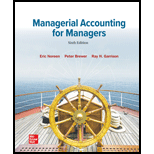
1.
Introduction:
Margin of safety: It is supposed to be the difference amount of actual sales and the break-even sales. It plays an important role by depicting the revenue value which can be reduced to equalize to the break-even point of no profit- no loss.
The contribution margin per unit.
2.
Introduction:
Margin of safety: It is supposed to be the difference amount of actual sales and break-even sales. It plays an important role by depicting the revenue value which can be reduced to equalize to the break-even point of no profit- no loss.
The contribution margin ratio.
3.
Introduction:
Margin of safety: It is supposed to be the difference amount of actual sales and break-even sales. It plays an important role by depicting the revenue value which can be reduced to equalize to the break-even point of no profit- no loss.
The variable expense ratio.
4.
Introduction:
Margin of safety: It is supposed to be the difference amount of actual sales and break-even sales. It plays an important role by depicting the revenue value which can be reduced to equalize to the break-even point of no profit- no loss.
The net operating income if sales increases to 1001 units.
5.
Introduction:
Margin of safety: It is supposed to be the difference amount of actual sales and break-even sales. It plays an important role by depicting the revenue value which can be reduced to equalize to the break-even point of no profit- no loss.
The net operating income if sales decreases to 900 units.
6.
Introduction:
Margin of safety: It is supposed to be the difference amount of actual sales and break-even sales. It plays an important role by depicting the revenue value which can be reduced to equalize to the break-even point of no profit- no loss.
The net operating income if sales volume decreases by 100 units with an increase of $2 per unit in selling price.
7.
Introduction:
Margin of safety: It is supposed to be the difference amount of actual sales and break-even sales. It plays an important role by depicting the revenue value which can be reduced to equalize to the break-even point of no profit- no loss.
The net operating income with an increase in variable cost by $1, advertising cost by $1500 unit sales by 250 units.
8.
Introduction:
Margin of safety: It is supposed to be the difference amount of actual sales and break-even sales. It plays an important role by depicting the revenue value which can be reduced to equalize to the break-even point of no profit- no loss.
The break-even point in unit sales.
9.
Introduction:
Margin of safety: It is supposed to be the difference amount of actual sales and break-even sales. It plays an important role by depicting the revenue value which can be reduced to equalize to the break-even point of no profit- no loss.
The break-even point in dollar sales.
10.
Introduction:
Margin of safety: It is supposed to be the difference amount of actual sales and break-even sales. It plays an important role by depicting the revenue value which can be reduced to equalize to the break-even point of no profit- no loss.
The number of units to be sold to achieve a target profit of $5000.
11.
Introduction:
Margin of safety: It is supposed to be the difference amount of actual sales and break-even sales. It plays an important role by depicting the revenue value which can be reduced to equalize to the break-even point of no profit- no loss.
The margin of safety in dollars along with its percentages.
12.
Introduction:
Margin of safety: It is supposed to be the difference amount of actual sales and break-even sales. It plays an important role by depicting the revenue value which can be reduced to equalize to the break-even point of no profit- no loss.
The degree of operating leverage.
13.
Introduction:
Margin of safety: It is supposed to be the difference amount of actual sales and break-even sales. It plays an important role by depicting the revenue value which can be reduced to equalize to the break-even point of no profit- no loss.
To determine: The degree of operating leverage when the percent in net operating income increases with an increase of 5% in sales.
14.
Introduction:
Margin of safety: It is supposed to be the difference amount of actual sales and break-even sales. It plays an important role by depicting the revenue value which can be reduced to equalize to the break-even point of no profit- no loss.
The degree of operating leverage when total variable expenses are $6000; total fixed expenses are $12000.
15.
Introduction:
Margin of safety: It is supposed to be the difference amount of actual sales and break-even sales. It plays an important role by depicting the revenue value which can be reduced to equalize to the break-even point of no profit- no loss.
The estimated percent increase in net operating income of a 5% increase in sales.
Want to see the full answer?
Check out a sample textbook solution
Chapter 2 Solutions
Loose Leaf For Managerial Accounting for Managers

 AccountingAccountingISBN:9781337272094Author:WARREN, Carl S., Reeve, James M., Duchac, Jonathan E.Publisher:Cengage Learning,
AccountingAccountingISBN:9781337272094Author:WARREN, Carl S., Reeve, James M., Duchac, Jonathan E.Publisher:Cengage Learning, Accounting Information SystemsAccountingISBN:9781337619202Author:Hall, James A.Publisher:Cengage Learning,
Accounting Information SystemsAccountingISBN:9781337619202Author:Hall, James A.Publisher:Cengage Learning, Horngren's Cost Accounting: A Managerial Emphasis...AccountingISBN:9780134475585Author:Srikant M. Datar, Madhav V. RajanPublisher:PEARSON
Horngren's Cost Accounting: A Managerial Emphasis...AccountingISBN:9780134475585Author:Srikant M. Datar, Madhav V. RajanPublisher:PEARSON Intermediate AccountingAccountingISBN:9781259722660Author:J. David Spiceland, Mark W. Nelson, Wayne M ThomasPublisher:McGraw-Hill Education
Intermediate AccountingAccountingISBN:9781259722660Author:J. David Spiceland, Mark W. Nelson, Wayne M ThomasPublisher:McGraw-Hill Education Financial and Managerial AccountingAccountingISBN:9781259726705Author:John J Wild, Ken W. Shaw, Barbara Chiappetta Fundamental Accounting PrinciplesPublisher:McGraw-Hill Education
Financial and Managerial AccountingAccountingISBN:9781259726705Author:John J Wild, Ken W. Shaw, Barbara Chiappetta Fundamental Accounting PrinciplesPublisher:McGraw-Hill Education





